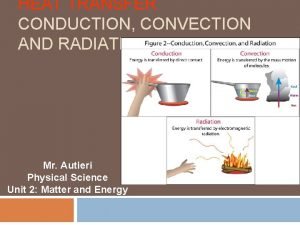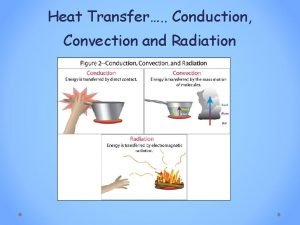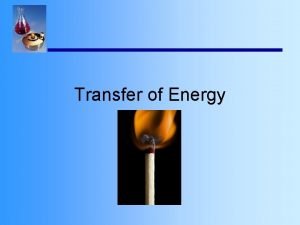Energy Transfer Three Methods of Energy Transfer There










- Slides: 10

Energy Transfer

Three Methods of Energy Transfer • There are three ways in which energy can be transferred, radiation, conduction, and convection. • The pot of boiling water in figure 1 demonstrates all three forms of energy transfer. • Energy is transferred from the flame to the pot through radiation. The pot than transfers the energy to the water through conduction, and the energy moves throughout the water through convection. Figure 1. The pot of boiling water illustrates all three methods of energy transfer.

Radiation • Energy transferred in the form of radiation does so through electromagnetic waves. These waves travel at the speed of light and can take many different forms. • Figure 2 shows the different forms of electromagnetic waves. It is important to note that higher forms of radiation, like gamma rays, have shorter wavelengths. • It is also important to note that when radiation is absorbed by a substance, that substance will reradiate the energy at a longer wavelength. For example, figure 3 is depicting the greenhouse effect which occurs when light hits the surface of the earth, the earth than reradiates that energy as infrared which is trapped by greenhouse gases like CO 2. Figure 2. The electromagnetic spectrum. Figure 3. Diagram showing the greenhouse effect

Earth’s Magnetic Field • • Light and heat are not the only things emitted from the sun. The sun also emits a stream of energized, charged particles called the solar wind. If the earth did not have protection from these charged particles, over time the solar wind would blow much of Earth’s atmosphere, including the ozone layer, into space. Eventually we would most-likely become a frozen, lifeless, desert like Mars is today. In fact Mars was once very similar to modern-day earth. It had oceans, rivers, volcanoes, clouds, and many other features you find on Earth. However, its core solidified and it lost much of its magnetic Figure 4. Diagram of Earth’s magnetic field. As time passed, the solar wind stripped Mars of its atmosphere and with it its oceans, rivers, and maybe even life. Thankfully this hasn’t happened to Earth because, unlike Mars, Earth’s outer core is composed of liquid iron and nickel (both metals) that spins. When a liquid metal rotates it generates a magnetic field (figure 4). Earth’s magnetic field deflects much of the solar wind. Some of these charged particles are directed towards the poles, where they energize the molecules in the atmosphere causing them to glow. We call these the aroura borealis (northern lights) and the aroura australis (southern lights) (figure 5). Figure 5. The northern lights.

The Ozone Layer • Ozone (O 3), is a naturally occurring gas that forms in the upper atmosphere when ultraviolet radiation from the sun splits an oxygen molecule, which later joins an oxygen molecule turning breathable oxygen (O 2) into ozone (O 3). • Although ozone at ground level is a form of air pollution and causes asthma and other breathing problems, in the stratosphere (upper atmosphere) it absorbs harmful ultraviolet radiation. In the late 1920 s Thomas Midgley Jr. found a new group of molecules to use as a refrigerant called chlorofluorocarbons (CFC’s). CFC’s were used in many applications including refrigerants, degreasing solvents, and aerosol cans. By the late 1970’s scientists became aware of the very destructive effects CFC’s had on ozone destruction. By the mid 1980’s the ozone layer had become very thin in areas around the poles. The reporting of the “hole” in the ozone layer (figure 6) led many countries to sign the Montreal Protocol in 1987 which was a treaty to phase out destructive ozone gases, including CFS’s, by the year 2000. As a result of the phasing out of destructive ozone molecules, it appears that the ozone layer is starting to repair itself. • • • Figure 6. The series of diagrams above show the growing “hole” in the ozone layer located above Antarctica. A similar thinning of the ozone can be found above the arctic.

Conduction • Conduction is the transfer of energy through the direct contact of molecules. All heat flows from areas of higher potential energy to areas of lower potential energy (heat flows from hot to cold). • Because air is a very good insulator, conduction plays a very small role in energy transfer with in the atmosphere, however rocks can affectively conduct heat and therefore conduction plays a key role in the formation of some metamorphic rocks. Figure 7. The heat from the magma • Heat from bodies of magma will move through the rock chamber causes the surrounding rock to by means of conduction. This heat alters the chemistry metamorphisize into new rock, like limestone turning into marble. of the surrounding rocks creating contact metamorphic rocks like marble (figure 7).

Convection • Convection is the transfer of heat in a fluid (anything that can flow) as a result in changes in temperature which result in changes in density. • When a fluid is heated up the atoms will begin to vibrate faster and spread out, making them less heavy for their size (less dense). As a result they will move upwards. As they move away from their heat source they will cool, contract (becoming more dense) and move down. This movement creates a circular motion called a convection current (figure 8). Figure 8. The diagram above and the video below both show convection currents.

Convection in the Hydrosphere • The hydrosphere includes all of the waters on the earth. • As you can see from figure 9, convection plays a primary role in the creation of the ocean currents. Hot water near the equator is forced outwards towards the holes, where it cools, sinks, and returns to the equatorial region. Figure 9. The diagram above is from the Earth Science Reference Tables and shows the ocean currents. The video below explains convection in more detail.

Convection in the Atmosphere • The atmosphere includes all of the gases on the earth. • Both localized wind and global wind patterns are the result of the equal heating of Earth’s surface which results in the development of convection currents (figure 10). Figure 10. Diagram showing the movement of air (wind) as a result of convection.

Convection in the Lithosphere • The lithosphere is the rigid, rocky part of the earth that includes the crust and rigid mantle. • The upper part of the mantle consists of a soft rock known as the asthenosphere. This layer of the mantle slowly moves and drives plate tectonics. The video above shows the process of convection and how it relates to plate tectonics.
 Energy energy transfer and general energy analysis
Energy energy transfer and general energy analysis Energy energy transfer and general energy analysis
Energy energy transfer and general energy analysis Inlay wax pattern fabrication
Inlay wax pattern fabrication How to calculate machine hour rate
How to calculate machine hour rate Transfer price meaning
Transfer price meaning Conduction convection radiation examples
Conduction convection radiation examples Radiation travels in straight lines
Radiation travels in straight lines Specific purpose statement
Specific purpose statement Pattern development engineering
Pattern development engineering Natural asset companies
Natural asset companies Rough sketch and final sketch
Rough sketch and final sketch



















